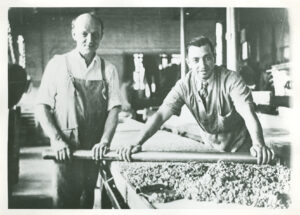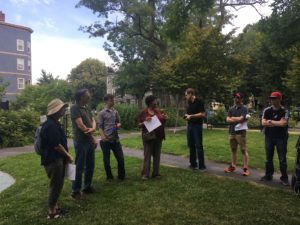Early Days at Newtowne Court
By Jane McGuirk Richards, 2014
We moved into Newtowne Court, door 30, apartment 265, in 1938, when I was one year old. We were among the first families to move in. There were seven of us, five children—two sets of twin girls and a single boy. Newtowne Court was a new concept in low income housing. Before Newtowne Court we were living in a cold-water flat. Our new home had three bedrooms and one bathroom. When we moved out in 1955, there were seven children—five girls and two boys. It is comical when I hear how families today need more bathrooms for their small families.
I felt I had 527 playmates, the number of children in Newtowne Court! Most of the kids in the Court used the Margaret Fuller House (MFH), and Washington Elms kids tended to use the Neighborhood House. The MFH was straight across Windsor Street and one block over on Cherry Street. We used their outdoor play space, the gym, and attended dancing, music, and sewing classes. My sister Betty and I went to the MFH Camp Newton.
Every Wednesday in the summer at the Neighborhood House they showed movies. We brought a box or small chair, carried it across Washington Street, through the Elms, and over to the yard at the Neighborhood House. The evening would start with a serial like Zorro and cartoons, and when it got dark, the main feature would come on. When it was over, we went back carrying our chairs and boxes.
One evening while walking through the Court I saw that someone had a blue light in their room, and I could see a screen through their window. This family had a magnifying screen in front of the TV screen because it was so small. Sometime later I was able to twist the windows open in my apartment in such a way as to see the reflection of the TV next door in my window. We would watch The Dinah Shore Show in the reflection, and we argued as to who could sit by the window. When the mother next door got wind of it, she moved the TV. We did not get a TV until we moved in 1955.
We would go up on the roof of Newtowne Court with our beach towels and our radios. On a rainy day we could go through our continuous cellar, from one side of the Court to the other. The laundry was in the basement, and we played down there. There were bins, and each tenant had a bin to hang their clothes. The big outdoor area we loved was in front of the gym with two showerheads in the summer. In the winter they froze it, and people went ice skating. In the gym we would have a huge Halloween party every year.
My mother was from Ireland, but her neighbors were American born. There was such support for women and especially mothers. During war time women helped each other; food and clothes were shared. People helped each other with sewing. We did not have a car until we moved out in 1955. Most of the men and women walked to their jobs. My father worked in One Kendall Square for a trucking company. My mother worked as a cook for wealthy families on Brattle Street. The man across the hall worked on Main Street in an auto dealership. Another man worked in a candy factory on Main Street. Several neighbors worked in Ward’s bakery behind Central Square. Everyone knew their courtyard. Because we did not have cars, people came door to door to sell linens, dishtowels, Fuller brushes, and big bottles of bleach.
We went to Gordon’s Central Square Theater. I saw Ted Williams there. Because we did not have TV, that was where people would go. I remember seeing Song of the South. During the war years we could get into the movies for free if we collected metal for the war effort. We would hear the air raid sirens. My neighbor wore a white air-raid warden’s hat, and she would go door to door telling us to turn off the lights in order to protect us from enemy planes bombing the Court. We got a ration book of stamps for buying food. We would go to Paul’s (a sub shop), which is still there, on the corner of School and Windsor streets.
People working for Polaroid came across the street dressed in their white coats asking to take pictures. Edwin Land may even have come over to take our pictures when he was working on the [instant] camera. We went to Jimmy’s and the Mahlowitz’s market. There were many small grocery stores serving the Elms and the Court.
Kids went to Catholic schools and to the Maynard school. We were members of St. Mary’s Parish even after leaving the Court. In the ’60s when I was a young mother with kids, I fought to stop the Inner Belt, which would have come down Norfolk Street and torn the parish apart. Father Paul McManus helped lead the group that fought it. There is a mural on Magazine Street in Cambridgeport depicting the people stopping the shovel. The mural means people power! It is history. People can be successful in fighting big powers.
Over time the population in the Court changed. There were more single-parent families, more mothers raising kids alone. Growing up, I knew one person on welfare. In later years there were terrible and unfair stereotypical images of the development. This was not the case when I was growing up. It is not fair to those who live there now.
My philosophy is that public housing should be on every street. There should be no segregation. Subsidized housing should be mixed with all other housing. The goal should be to have low-income housing on every street of every city. We should live with people of all incomes and blend in as neighbors, not be segregated as low-income people living in this special place.
I have four children and five grandchildren and one on the way. My two daughters want to live in Cambridge, but it is too expensive. One daughter now lives with us but wants her own household. The loss of rent control has been devastating to the city. We are the fourth generation on my street. It is a sad indictment when we make the city attractive for those with money while so many others cannot afford to live. I would hate to have to leave Cambridge, especially as I get older.
This story first appeared in the January 2004 issue of 4word.



